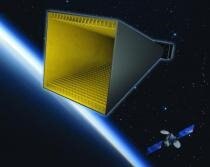Cheaper, lighter and more energy-efficient broadband devices on communications satellites may be possible using metamaterials to modify horn antennas, according to engineers from Penn State and Lockheed Martin. “Existing horn antennas have adequate performance, but have undergone little change over several decades except for advances in more accurate modeling techniques. Modifications enabled by metamaterials can either enhance performance, or they can lower the mass and thus lower the cost of putting the antenna in space,” said Erik Lier, technical Fellow, Lockheed Martin Space Systems Co. Lighter antennas cost less to boost into space and more energy-efficient antennas can reduce the size of storage batteries and solar cells, which also reduces the mass. Metamaterials derive their unusual properties from structure rather than composition and possess exotic properties not usually found in nature. The engineers specifically designed their electromagnetic metamaterials to avoid previous limitations of narrow bandwidth and high intrinsic material loss, which results in signal loss. Their aim was not to design theoretical metamaterial-enhanced antennas, but to build a working prototype. They wanted an antenna that could work over a broad band of frequencies, at least an octave, and improve upon existing antennas. An octave in the radio frequency spectrum is a stretch of bandwidth where the upper frequency is twice the lower frequency, 3.5 to 7 gigahertz for example, which is wider than the standard C-band. Horn antennas are part of communications satellites that relay television and radio signals, telephone calls and data around the world. Two commonly used microwave bands on satellites are C-band (used for long-distance radio and telecommunications) and Ku-band (used for broadcast television and remote television uplinks). Ku-band (12 to 18 gigahertz) antennas require small structural intervals that are easily fabricated using conventional printed circuit board manufacturing techniques, while super extended C-band (3.4 to 6.725 gigahertz) could be achieved with a simple wire grid structure that is easily manufactured with an interval of about a quarter of an inch between wires. The researchers chose to convert the C-band application into a prototype.
Eavesdropper

